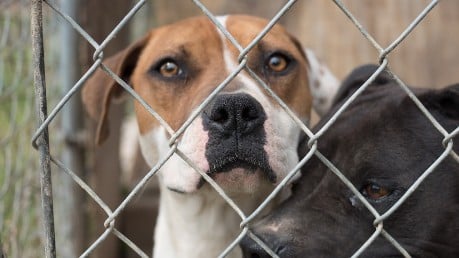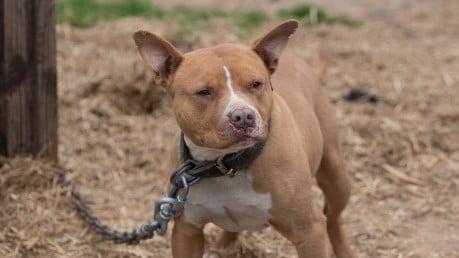As a social media assistant for People for the Ethical Treatment of Animals (PETA), I spend most of my days responding to people who post comments or questions on PETA’s Facebook and Twitter pages. But I recently visited PETA’s headquarters in Norfolk, Virginia, the Sam Simon Center, and volunteered with our fieldworkers for two days. This experience made it clear to me why PETA supports breed-specific protection measures for pit bulls—namely laws mandating that these dogs be spayed or neutered and that owners meet minimum standards of care, including no chaining.
Both days were spent in rural North Carolina, mostly checking up on dogs PETA’s fieldworkers have been working to help. On the first day, I met so many sweet dogs, mostly pit bulls. It was heartbreaking to see a little pit-mix puppy so desperate for love that he ignored dog treats in order to keep having his tummy rubbed. The puppy’s mother had no shelter. PETA had previously provided her with a doghouse, and it was still on the property, but she is kept chained and couldn’t reach it. It took us less than 10 minutes to move the doghouse over to where the dog was now chained—a task that seemed to perplex her owners. We left both dogs with full stomachs, fresh water, straw and shelter. At houses on either side of this one, there were more dogs in the exact same situation.
My second day started off much differently. Our first stop was a home with four dogs, two inside and two kept chained outside. The owner brought out a pit bull he said had been “rescued” from a dogfighting ring. She kept lunging toward us, and the owner kept saying, “She’s so mean. This is why we keep her locked in a bedroom.”
Next thing I knew, I heard shouting and looked over at what I thought was the pit bull attacking another animal. I saw what looked like the dark fur of a lifeless animal lying in a ditch. The man pulled the pit bull off and took her inside. When I ran over to the ditch, I saw that the “dark fur” was actually a woman’s black pants. A neighbor had walked by and had been chatting with the man when the dog broke free and attacked her. Her shoes and hat had been knocked off, and she was lying there in complete shock. The muscles, tendons and fat had been ripped out of her arm, and some pieces had landed on her shirt and in the ditch next to her. It looked like a scene out of The Walking Dead.
Firefighters, police officers and an ambulance were soon on the scene. They treated the woman for a while and then prepared her to be transported to a trauma center. It was around that time that the shock wore off and she began to feel the pain. I will never get the image of her arm or the sound of her cries of pain out of my head.
I don’t have any friends or family nearby who own pit bulls. Before this, I had never even interacted with them. So I didn’t have any perspective whenever I read about PETA’s stance on pit bulls. My experiences with PETA’s fieldworkers changed that.
The measures that PETA supports—mandatory spay/neuter laws for pit bulls and required minimum standards of humane care for them—would greatly help those sweet, sad dogs I met on my first day, who were living among garbage and their own waste. They would also help the puppy I saw with a chain around his neck that weighed more than he did and the pit bull kept locked inside a bedroom who will now most likely be euthanized because she attacked someone. It’s easy to feel that you’re right in saying, “Don’t discriminate against pits,” when you don’t see this sort of thing every day as PETA’s fieldworkers do.
Breed-specific protection for pit bulls would also help people like Miss E., the human victim here, who will probably never have full use of her arm again—if her arm can be saved at all.
Alexandra Phillips is a social media assistant for People for the Ethical Treatment of Animals (PETA), 501 Front St., Norfolk, VA 23510.
This article was first posted exactly a year ago; re-posting in light of recent pit-bull related discussion and news.






